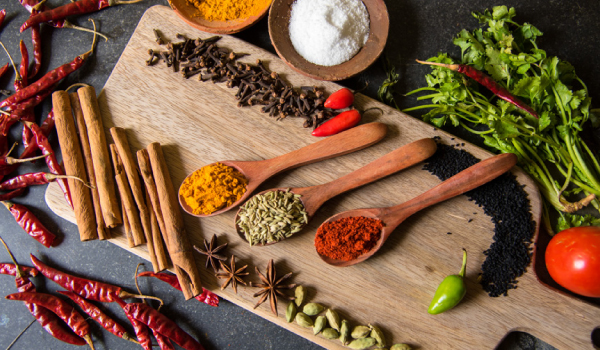
People have been using herbs1 and spices for thousands of years. Generally, herbs come from the green leaves of plants or vegetables. Spices come from other parts of plants and trees. For example, cinnamon comes from the hard outer cover of cinnamon plants. The spice ginger comes from the part of the ginger plant that grows underground. Some herbs and spices are valued for their taste. They help to sharpen the taste of many foods. Others are chosen for their smell. Still others were used traditionally for health reasons. Some herbs and spices may be gaining importance in modern medicine. For example, American researchers say red pepper could help people seeking to lose weight. They say this could be especially true for people who do not usually add spices to their food. The researchers said turmeric may reduce evidence of damage in the brains of patients with Alzheimer's disease. For this reason, the researchers designed a study that examined results from a mentalperformance test of older Asian adults. The study involved curry, which contains turmeric. The adults were 60 to 93 years old. None had severe memory losses. Those who sometimes ate curry did better on the tests than individuals who rarely or never ate curry. This was also true of those who ate it often or very often. The work of the Mayo Clinic and its medical experts is world famous. In its Health Letter several years ago, the Mayo Clinic provided more evidence that herbs and spices can aid health. Its experts said spices could reduce salt use for people with health conditions like high blood pressure. The experts said some plant chemicals are high in antioxidants. In addition to turmeric, these include cinnamon, ginger, oregano, sage, and thyme. The experts also said antioxidants like garlic, rosemary, and saffron have qualities that could fight cancer. They also said limited evidence shows that cinnamon, fenugreek, and turmeric may affect blood sugar levels in people with diabetes.
人們使用藥草和香料已有數千年。一般而言,香草來自植物或蔬菜的綠葉,而香料則來自植物和樹木的其他部位。舉例來說,肉桂來自肉桂植物的外殼,而香料用的薑則來自薑科植物生長在地下的部位。 有些藥草和香料受到重視,是因為其味道可以為食物提味;有些香料被採用,則是因為具有特殊氣味。還有一些藥草香料,在傳統上是因為健康價值才為人所用。 部分藥草和香料在現代醫學中可能愈來愈重要。例如,美國的研究人員發現,紅辣椒對於想減肥的人有幫助。他們表示,紅辣椒對於那些平常不會在食物中添加香料的人特別有效。 研究人員認為薑黃可以降低阿茲海默症患者腦部損傷的跡象。因此,研究人員設計了一項研究,以亞洲年長者為測試對象,探討食用含有薑黃的咖哩,對他們心智行為表現的影響。 這群受試者年齡介於60到93歲,都沒有嚴重的記憶損失。這些人當中有時會吃咖哩的人,心智表現比那些很少或從未吃咖哩的人來得好。經常或極為常吃咖哩的人心智表現也很好。 梅奧診所和其醫療專家的研究成果舉世聞名。他們在幾年前發表的「健康信箋」中提供了更多證據,證明藥草和香料對健康有所助益。參與研究的專家說,為有高血壓等症狀的患者烹調食物時,使用香料可以減少鹽的用量。 專家表示,有些植物的化學成分中含有豐富的抗氧化物。這類植物除了薑黃以外,還包含了肉桂、生薑、奧勒岡、鼠尾草和百里香。 專家們還說,大蒜、迷迭香和番紅花這類抗氧化物含有抗癌成分。他們還認為有部分證據顯示,肉桂、葫蘆巴和薑黃可能會影響糖尿病人的血糖值。 |
沒有留言:
張貼留言